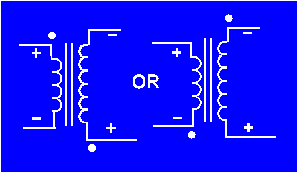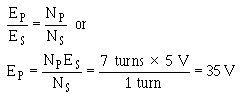|
ANSWERS TO QUESTIONS Q1. THROUGH Q30.
A1. The transfer of energy from one circuit to another circuit by electromagnetic
induction.
A2. Primary winding; secondary winding; core.
A3. Air; soft iron; steel.
A4. Hollow-core type; shell-core type.
A5. Primary to source; secondary to load.
A6. Additional insulation is provided between the layers of windings in the high-voltage
transformer.
A7. air-core transformer
iron-core transformer
iron-core center tapped transformer
A8. A voltage is applied to the primary, but no load is connected to the secondary.
A9. Exciting current is the current that flows in the primary of a transformer with the
secondary open (no load attached).
A10. Self-induced or counter emf.
A11. The magnetic lines generated by the current in the primary cut the secondary windings
and induce a voltage into them.
A12. In phase. Remember, the cemf of the primary is 180 degrees out of phase with the
applied voltage. The induced voltage of the secondary of an unlike-wound transformer is
also 180 degrees out of phase with the primary voltage.
A13.  Note: Remember
the dots indicate areas of like polarity, NOT a particular polarity. Note: Remember
the dots indicate areas of like polarity, NOT a particular polarity.
A14. Lines of flux generated by one winding which do not link the other winding.
A15. It causes K to be less than unity (1).
A16. Step up.
A17. 
A18. 
A19. 
A20. 
A21. 
A22. 
A23. Copper loss, eddy-current loss, and hysteresis loss.
A24. 
A25. The inductive reactance at 60 hertz would be too low. The resulting excessive current
would probably damage the transformer.
A26. Power transformer Autotransformer Impedance-matching transformer Audio-frequency
transformer Radio-frequency transformer
A27. Primary leads-black; secondary leads-red.
A28. Carelessness.
A29. Discharge them by shorting them to ground.
A30. To minimize the possibility of providing a path for current through your body.
|











